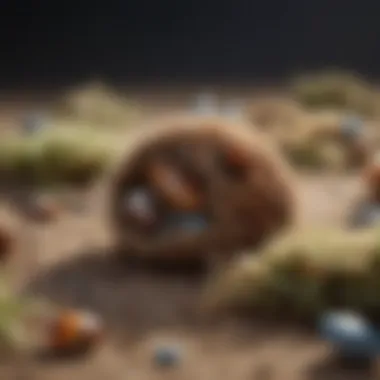Unveiling the Intricate World of Carpet Bugs: Impacts, Prevention, and Eradication


Animal Species Profile
Understanding the intricate world within your carpet involves a detailed insight into the animal species that are often overlooked. These tiny pests, from fleas to dust mites, thrive within the fibers, posing potential health risks and hygiene concerns. Exploring the physical characteristics and appearance of these creatures provides a foundation for identifying and understanding these uninvited guests. Their minuscule size and translucent bodies often make them hard to detect with the naked eye. Although small in stature, these bugs can have a significant impact on both human health and overall hygiene.
Natural Habitat and Distribution
The natural habitat and distribution of these bugs are not limited solely to your carpet but extend to various areas within your living environment. These pests can be found in upholstery, bedding, and even stuffed toys. Their ability to adapt to different environments makes them resilient and challenging to eradicate completely. Understanding their preference for humid conditions or dark, secluded spaces helps in identifying potential hotspots for infestation. By learning more about their favored habitats and common hiding spots, one can take proactive measures to minimize their presence and prevent infestations.
Behavior and Social Interactions
Despite their minuscule size, these bugs exhibit fascinating behavior patterns and social interactions within the carpet ecosystem. From feeding on organic matter to reproducing at a rapid rate, their activities contribute to the perpetuation of their population. Understanding their behavior sheds light on their life cycles, enabling homeowners to disrupt their breeding and feeding patterns effectively. By delving into their social interactions, one can uncover how these pests communicate, organize their colonies, and navigate their microcosm within the carpet fibers.
Introduction
When we think of our homes as sanctuaries, the presence of bugs within our carpets may come as an unwelcome surprise. This article serves as a comprehensive exploration of the hidden world of these unwanted guests, shedding light on the types of pests commonly found, their implications on health and hygiene, and effective strategies for prevention and eradication. By delving into the intricate details of carpet infestations, we aim to equip readers with the knowledge and tools necessary to maintain a clean and pest-free living environment.
Unveiling the Unseen
The prevalence of bugs in indoor spaces
The insidious nature of bugs infiltrating our indoor spaces is a concerning reality that often goes unnoticed. From microscopic mites to resilient carpet beetles, these pests find refuge in the fibers of our carpets, proliferating unseen. The prevalence of bugs in indoor spaces underscores the pervasive nature of these uninvited guests, highlighting the need for vigilance in maintaining a hygienic living environment. Despite their diminutive size, these bugs pose a significant threat to our well-being, making the eradication of these hidden intruders a paramount concern.
The carpet as a breeding ground for pests
Our carpets, intended to provide comfort and warmth, unwittingly become breeding grounds for a multitude of pests. The cozy fibers of our floor coverings offer an ideal habitat for bugs to thrive, laying eggs and propagating their populations unnoticed. This insidious colonization transforms our carpets from a place of comfort to a haven for unwelcome visitors, jeopardizing not only the integrity of the flooring but also the health of inhabitants. Understanding the carpet as a breeding ground for pests underscores the importance of regular maintenance and proactive measures to mitigate infestations, safeguarding our living spaces from these unseen threats.
Health and Hygiene Concerns
Allergies and respiratory issues linked to carpet bugs
The unsettling connection between carpet bugs and respiratory ailments is a significant health concern that cannot be overlooked. Allergies triggered by these nefarious pests can manifest as sneezing, coughing, and respiratory distress, compromising the well-being of individuals exposed to infested carpets. Understanding the link between allergies and respiratory issues linked to carpet bugs emphasizes the urgency of addressing infestations promptly to protect the health of residents and maintain a hygienic living environment.
Potential spread of diseases


Beyond allergies, the potential dissemination of diseases by carpet bugs poses a grave risk to households. These vectors of infection can harbor pathogens and bacteria, facilitating the spread of illnesses among unsuspecting occupants. The potential spread of diseases highlights the critical importance of effective pest management strategies and thorough sanitation practices to eradicate the source of contagion, minimizing health risks and promoting a safer living environment for all.
Signs of Infestation
Visible pests or eggs
The presence of visible pests or eggs within the weave of our carpets serves as a distressing indication of infestation. Spotting these intruders crawling or nestled within the fibers is a stark reminder of the urgent need for intervention. The visibility of pests or eggs demands swift action, prompting homeowners to implement rigorous cleaning regimens and targeted pest control measures to quell the infestation and restore the sanctity of their living spaces.
Itchiness and skin irritations
As the insidious effects of carpet bugs manifest, individuals may experience unexplained itchiness and skin irritations. The discomfort caused by these pests can range from mild itching to severe allergic reactions, prompting further investigation into the underlying cause. Itchiness and skin irritations serve as physical indicators of a deeper issue, compelling residents to address the root of the problem through meticulous cleaning, preventive measures, and, if necessary, professional pest control interventions.
Common Types of Carpet Bugs
Understanding the different types of carpet bugs is crucial in maintaining a clean and pest-free living environment. By delving into the characteristics and behaviors of each type, we can better identify and address potential infestations promptly. This section will provide valuable insights into three common types of carpet bugs: Carpet Beetle, Dust Mites, and Fleas.
Carpet Beetle
Carpet beetles, small insects belonging to the family Dermestidae, are a prevalent nuisance in indoor spaces. Their appearance and behavior are key factors in understanding how they thrive in carpets. With their small, oval-shaped bodies covered in scales, carpet beetles can easily go unnoticed. This camouflage helps them evade detection and continue to cause damage to carpets over time. Their behavior of feeding on natural fibers like wool and silk highlights the importance of addressing infestations promptly to prevent extensive damage. While carpet beetles may not pose direct health risks to humans, their presence can lead to significant carpet damage, making them a crucial focus in our discussion about common carpet bugs.
Appearance and behavior
Carpet beetles' inconspicuous appearance and nocturnal behavior make them challenging to eradicate completely. Their ability to feed on a variety of materials in the carpet, including hair, fur, and lint, underscores the importance of thorough cleaning and preventive measures to deter infestations.
Damage caused to carpets
The damage caused by carpet beetles stems from their feeding habits, which target natural fibers commonly found in carpets. This results in irregular holes and patches in the carpet, leading to deterioration over time. Understanding the extent of damage carpet beetles can cause underscores the necessity of proactive pest management strategies to safeguard carpets from infestation and subsequent harm.
Dust Mites
Dust mites, microscopic arachnids thriving in indoor environments, contribute to a range of health implications related to carpet infestations. Their presence in carpets can exacerbate respiratory issues and allergies in susceptible individuals, highlighting the importance of prevention methods to reduce exposure.
Health implications


The allergens produced by dust mites can trigger asthma symptoms and allergic reactions, making them a significant concern for individuals with respiratory conditions. Understanding the role of dust mites in indoor air quality emphasizes the need for effective prevention strategies to mitigate health risks associated with carpet infestations.
Prevention methods
Preventing dust mite infestations involves maintaining optimal humidity levels and reducing dust accumulation in carpets through regular cleaning. Implementing preventive measures such as using allergen-proof covers and washing bedding frequently can significantly reduce the presence of dust mites, promoting a healthier indoor environment.
Fleas
Fleas, parasitic insects that commonly affect pets and humans, pose unique challenges when infesting carpets. Their effects on pets and humans underscore the importance of timely intervention and treatment options to eradicate infestations and prevent recurrence.
Effects on pets and humans
The bites of fleas can cause itching, skin irritation, and allergic reactions in both pets and humans. Infestations can lead to discomfort and potential health complications, necessitating swift actions to address the issue effectively.
Treatment options
Addressing flea infestations in carpets often requires integrated pest management approaches, including vacuuming, steam cleaning, and the use of insecticidal treatments. Understanding the efficacy of different treatment options enables effective elimination of fleas and prevents re-infestation, ensuring a pest-free living environment for pets and humans.
Prevention and Control
In the compelling domain of bug infestation within carpets, the quintessential factor of Prevention and Control emerges as the paramount focus. This section extensively delves into the importance of taking proactive measures to thwart pest intrusion and curb potential health hazards. The emphasis lies on implementing specific strategies aimed at maintaining a hygienic living environment devoid of uninvited guests. By delineating key elements revolving around Prevention and Control, this article elucidates the significance of regular vigilance and strategic intervention in combating carpet bugs.
Regular Cleaning Practices
Vacuuming
Venturing into the realm of carpet maintenance, the practice of Vacuuming occupies a pivotal role in ensuring the sanitation and longevity of carpets. Its meticulous approach toward eradicating dust particles, debris, and potential insect eggs underscores its indispensable contribution to pest prevention. Vacuuming stands out as a popular choice for enthusiasts looking to maintain a clean and allergen-free living space. The unique feature of Vacuuming lies in its ability to reach deep into carpet fibers, extracting hidden contaminants for improved indoor air quality. Users appreciate its convenience but must remain aware of its occasional inefficacy in addressing deeply embedded pests.
Steam cleaning
Transitioning to a more intensive method, Steam cleaning epitomizes a holistic approach to carpet sanitation. Its effectiveness in eliminating bacteria, dust mites, and other allergens stems from the profound steam penetration that sanitizes carpets to their core. The strategic use of high-temperature steam not only disinfects but also revitalizes carpet fibers, restoring them to their pristine state. Endorsed for its eco-friendly nature and deep-cleaning capabilities, Steam cleaning stands as a favored choice for individuals seeking a thorough bug extermination method. While its advantages include environmental safety and efficient allergen removal, users should be mindful of longer drying times as a potential drawback.
Natural Remedies


Essential oils
Embarking on the realm of organic solutions, Essential oils emerge as a compelling alternative for bug control and carpet maintenance. Their natural, aromatic properties not only repel pests but also infuse a pleasant fragrance into living spaces. The standout characteristic of Essential oils lies in their dual functionality of warding off insects and creating a conducive ambiance. Widely embraced for their non-toxic composition and sustainable impact, Essential oils emerge as a popular choice among eco-conscious individuals. Despite their advantages in pest deterrence and mood enhancement, users should exercise caution in appropriate dilution and usage to prevent adverse effects.
Diatomaceous earth
Turning towards a mineral-based approach, Diatomaceous earth establishes itself as a potent remedy against carpet bugs and other household pests. Its abrasive texture and desiccant properties prove effective in dehydrating and neutralizing insects upon contact. The distinctive feature of Diatomaceous earth lies in its non-toxic nature, making it a safe alternative for households with pets and children. Praised for its residual efficacy and natural composition, this remedy garners favor among individuals seeking chemical-free pest control solutions. While its benefits include long-lasting pest control and minimal environmental impact, users should handle it with care to avoid respiratory irritation.
Professional Assistance
When to seek pest control services
Navigating the realm of professional intervention, the decision of When to seek pest control services hinges on the severity of infestation and individual preferences. This juncture accentuates the importance of timely action to address persistent pest issues beyond home remedies' scope. The key characteristic of professional pest control services lies in their expertise and specialized equipment tailored to combat diverse pest species effectively. Opting for professional assistance proves beneficial for individuals grappling with extensive infestations and seeking long-term solutions. While the advantages include customized treatment plans and professional guidance, the associated costs and potential chemical exposure constitute notable considerations.
Maintenance tips
Transitioning to the realm of preventive care, Maintenance tips offer invaluable insights into sustaining a bug-free environment post-treatment. Their emphasis on regular inspections, sealing entry points, and implementing basic hygiene practices plays an instrumental role in deterring future pest incursions. The key characteristic of Maintenance tips underscores their proactive nature, which shields residences from recurring pest infiltrations. Adopting these tips not only ensures continued pest control efficacy but also fosters a lasting clean and healthy living environment. While their advantages encompass cost-effectiveness and sustainability, users should adhere to consistent upkeep to reap the full benefits.
Conclusion
In the hustle and bustle of daily life, the presence of bugs in our carpets might seem like a minor inconvenience. However, delving deeper reveals a lurking ecosystem fraught with potential health hazards and hygiene risks. The importance of understanding and addressing these unwelcome guests cannot be overstated. By unraveling the mysteries of carpet bugs, we not only safeguard our well-being but also fortify our living spaces against intruders that stealthily threaten our health.
While the termite seems like the dominant player in the pest world, carpet bugs are silent infiltrators that can wreak havoc if left unchecked. Their diminutive size belies the significant impact they can have on our respiratory health and overall hygiene standards. By proactively engaging with the signs of infestation and taking necessary preventive actions, we can carve out a bug-free haven in our homes, ensuring a sanctuary free from the unseen threats that dwell within our cozy carpets.
In the realm of pest control, vigilance is indeed the cost of freedom from unwanted bugs. The diligence involved in maintaining a clean and healthy home goes beyond mere aesthetics. It is a shield we wield against microscopic invaders that compromise our well-being. By integrating proactive measures into our cleaning routines and embracing natural remedies, we establish a paradigm where bugs find no quarter to thrive. Investing in professional assistance when needed cements our dedication to upholding a bug-free environment, buttressing our resolve against the encroachment of these tiny adversaries.
Ensuring a Bug-Free Environment
The importance of proactive measures
In the landscape of pest management, the importance of proactive measures emerges as a cornerstone in the defense against carpet bugs. By preemptively addressing conducive conditions and vulnerable areas in our homes, we erect barriers that repel potential infestations. The proactive stance necessitates a keen eye for detail, identifying subtle signs of bug presence before they escalate into full-blown problems. Regular maintenance and inspection routines become our arsenal, fortifying our living quarters against unwelcome intruders.
Embracing proactive measures transcends mere cleanliness; it embodies a mindset of prevention over cure. The proactive approach not only saves us from the turmoil of eradication but also fosters a habitat that nurtures our well-being. Integrating preventive strategies into our daily habits transforms our homes into bastions of health, where bugs find no quarter to establish their dominion.
Maintaining a clean and healthy home
At the heart of ensuring a bug-free environment lies the fundamental principle of maintaining a clean and healthy home. This tenet serves as the bedrock upon which our defenses against carpet bugs are built. Regular cleaning practices, such as vacuuming and steam cleaning, not only enhance the visual appeal of our carpets but also dismantle the very harboring grounds that attract bugs.
The key characteristic of maintaining a clean and healthy home is its dual nature of defense and rejuvenation. By purging our living spaces of dirt and debris, we not only eliminate sustenance sources for bugs but also create an environment that rejuvenates our senses. The unique feature of this practice lies in its ripple effect, where the cleanliness of our carpets extends to overall well-being, fostering a sanctuary that radiates freshness and hygiene.







